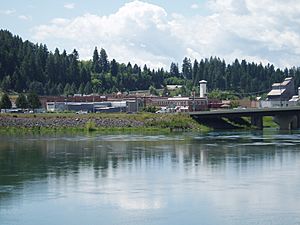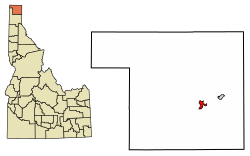Bonners Ferry, Idaho facts for kids
Quick facts for kids
Bonners Ferry
|
|
|---|---|

Bonners Ferry and the Kootenai River
|
|

Location of Bonners Ferry in Boundary County, Idaho.
|
|
| Country | United States |
| State | Idaho |
| County | Boundary |
| Area | |
| • Total | 2.51 sq mi (6.50 km2) |
| • Land | 2.35 sq mi (6.10 km2) |
| • Water | 0.15 sq mi (0.40 km2) |
| Elevation | 1,896 ft (578 m) |
| Population
(2020)
|
|
| • Total | 2,543 |
| • Estimate
(2019)
|
2,687 |
| • Density | 1,120.22/sq mi (432.59/km2) |
| Time zone | UTC-8 (Pacific (PST)) |
| • Summer (DST) | UTC-7 (PDT) |
| ZIP code |
83805
|
| Area codes | 208, 986 |
| FIPS code | 16-09370 |
| GNIS feature ID | 0396163 |
Bonners Ferry (Kutenai language: ʔaq̓anqmi) is the largest city and the county seat of Boundary County, Idaho, United States. The population was 2,543 at the 2010 census.
Contents
History
When gold was discovered in the East Kootenays of British Columbia in 1863, thousands of prospectors from all over the West surged northward over a route that became known as the Wildhorse Trail. Edwin Bonner, a merchant from Walla Walla, Washington, established a ferry in 1864 where the trail crossed the broad Kootenai River. In 1875, Richard Fry, and his Sinixt wife, Justine Su-steel Fry, leased the business, but the location retained the name of the original founder and later became the town of Bonners Ferry.
Before the gold rush, only a few visitors had come to the region; one of the first was explorer David Thompson, a cartographer for the North West Company. Thompson and four fellow fur traders arrived in 1808 to trade with the Lower Kootenais. Exhausted and famished, the local natives gave Thompson's party dried fish and moss bread. Thompson returned the next year and established a trading post on Lake Pend Oreille. He was followed in 1846 by Jesuit Priest Father DeSmet, a missionary to the Kootenai Tribe.
The Oregon question was settled by Oregon Treaty of 1846 which established the 49th Parallel north as the boundary between the U.S.A and British North America. Government surveyors of the Boundary Commission came in 1858 to establish the border between the United States and British Columbia.
With mines to the north, the community of Bonners Ferry began to flourish in the 1880s as a supplier. The Norwegian-built steamer Midge began service in 1883 and operated for the next 25 years, carrying passengers and freight between Bonners Ferry and British Columbia. The Great Northern Railway was built here in 1892, followed quickly by the Spokane International and the Kootenai Valley lines.
The village of Bonners Ferry was formally established in 1893, along the south bank of the Kootenai River. Scattered along the valley and benchland were a few ranches and homesteads. Numerous mines were developed in the nearby mountains, including the Continental Mine in the Selkirks. The lumber industry also grew rapidly. Bonners Ferry, perched on stilts to avoid the inevitable spring floods, appeared to be a boom town.
Moving into the 20th century, the town became the center of a lumbering and farming community. The valley land was drained, levees were constructed and farms were cleared on the benches. The rich Kootenai Valley became known as the "Nile of the North", while the Bonners Ferry Lumber Company grew to be one of the world's largest lumber mills. The downtown took shape as brick buildings were constructed, replacing those on stilts. Completion of the Libby Dam in 1975 lessened the threat of serious flooding. Today, much of Main Street dates from this initial period of solid, permanent construction.
On September 20, 1974, the Kootenai Tribe, headed by chairwoman Amy Trice, declared war on the United States government. Their first act was to post soldiers on each end of the highway that runs through the town and they asked people, to pay a toll to drive through what had been the tribe’s aboriginal land. The money would be used to house and care for elderly tribal members. Most tribes in the United States are forbidden to declare war on the U.S. government because of treaties, but the Kootenai Tribe never signed a treaty. The dispute resulted in the concession by the United States government and a land grant of 10.5 acres (42,000 m2) that is now the Kootenai Reservation.
Bonners Ferry is eight miles (13 km) from the site of the Ruby Ridge confrontation and siege in 1992.
In recent years, Mormon Fundamentalists from nearby Bountiful, British Columbia have established a presence in Bonners Ferry. They have brought with them the controversial practice of plural marriage.
Geography
Bonners Ferry is located at 48°41′32″N 116°19′3″W / 48.69222°N 116.31750°W (48.692110, −116.317626), at an altitude of 1,896 feet (578 m). According to the United States Census Bureau, the city has a total area of 2.61 square miles (6.76 km2), of which 2.44 square miles (6.32 km2) is land and 0.17 square miles (0.44 km2) is water.
Bonners Ferry has a humid continental climate (Köppen Dfb/Dsb) with cold, snowy winters and dry summers with hot days and cool nights. It is almost warm enough to be classed as a Mediterranean climate or oceanic climate, and despite the cold, snow depths above 10 inches (0.25 m) occur only on nine days in an average winter.
| Climate data for Bonners Ferry (1971–2000) | |||||||||||||
|---|---|---|---|---|---|---|---|---|---|---|---|---|---|
| Month | Jan | Feb | Mar | Apr | May | Jun | Jul | Aug | Sep | Oct | Nov | Dec | Year |
| Record high °F (°C) | 55 (13) |
61 (16) |
71 (22) |
89 (32) |
95 (35) |
105 (41) |
104 (40) |
101 (38) |
97 (36) |
84 (29) |
67 (19) |
56 (13) |
105 (41) |
| Average high °F (°C) | 33.3 (0.7) |
39.2 (4.0) |
49.5 (9.7) |
60.4 (15.8) |
69.3 (20.7) |
76.0 (24.4) |
83.1 (28.4) |
83.4 (28.6) |
72.3 (22.4) |
57.4 (14.1) |
41.3 (5.2) |
33.5 (0.8) |
58.2 (14.6) |
| Average low °F (°C) | 20.5 (−6.4) |
24.3 (−4.3) |
29.1 (−1.6) |
34.7 (1.5) |
41.6 (5.3) |
47.6 (8.7) |
50.7 (10.4) |
50.0 (10.0) |
41.9 (5.5) |
34.1 (1.2) |
28.6 (−1.9) |
22.1 (−5.5) |
35.4 (1.9) |
| Record low °F (°C) | −29 (−34) |
−25 (−32) |
−12 (−24) |
12 (−11) |
17 (−8) |
31 (−1) |
32 (0) |
28 (−2) |
15 (−9) |
11 (−12) |
−13 (−25) |
−33 (−36) |
−33 (−36) |
| Average precipitation inches (mm) | 2.70 (69) |
1.77 (45) |
1.49 (38) |
1.42 (36) |
1.76 (45) |
1.62 (41) |
1.02 (26) |
1.07 (27) |
1.16 (29) |
1.61 (41) |
3.03 (77) |
2.91 (74) |
21.56 (548) |
| Average snowfall inches (cm) | 16.0 (41) |
10.5 (27) |
3.4 (8.6) |
0.5 (1.3) |
0 (0) |
0 (0) |
0 (0) |
0 (0) |
0 (0) |
0.5 (1.3) |
9.2 (23) |
22.0 (56) |
62.1 (158.2) |
| Average precipitation days (≥ 0.01 inch) | 12.6 | 10.6 | 9.7 | 9.2 | 11.0 | 10.0 | 7.0 | 6.0 | 7.0 | 9.4 | 13.8 | 14.4 | 120.7 |
| Average snowy days (≥ 0.1 inch) | 7.8 | 4.9 | 2.0 | 0.3 | 0 | 0 | 0 | 0 | 0 | 0.4 | 3.5 | 9.0 | 27.9 |
| Source: NOAA (normals, 1971–2000) | |||||||||||||
Demographics
| Historical population | |||
|---|---|---|---|
| Census | Pop. | %± | |
| 1900 | 349 | — | |
| 1910 | 1,071 | 206.9% | |
| 1920 | 1,236 | 15.4% | |
| 1930 | 1,418 | 14.7% | |
| 1940 | 1,345 | −5.1% | |
| 1950 | 1,776 | 32.0% | |
| 1960 | 1,921 | 8.2% | |
| 1970 | 1,909 | −0.6% | |
| 1980 | 1,906 | −0.2% | |
| 1990 | 2,193 | 15.1% | |
| 2000 | 2,515 | 14.7% | |
| 2010 | 2,543 | 1.1% | |
| 2020 | 2,687 | 5.7% | |
| 2019 (est.) | 2,637 | 3.7% | |
| U.S. Decennial Census | |||
2010 census
As of the census of 2010, there were 2,543 people, 1,117 households, and 631 families residing in the city. The population density was 1,042.2 inhabitants per square mile (402.4/km2). There were 1,254 housing units at an average density of 513.9 per square mile (198.4/km2). The racial makeup of the city was 94.3 percent White, 0.2 percent African American, 2.0 percent Native American, 0.6 percent Asian, 0.2 percent Pacific Islander, 0.5 percent from other races, and 2.2 percent from 2 or more races. Hispanic or Latino of any race were 4.7 percent of the population.
There were 1,117 households, of which 27.6 percent had children under the age of 18 living with them, 39.1 percent were married couples living together, 12.5 percent had a female householder with no husband present, 4.8 percent had a male householder with no wife present, and 43.5 percent were non-families. 38.6 percent of all households were made up of individuals, and 20% had someone living alone who was 65 years of age or older. The average household size was 2.22 and the average family size was 2.91.
The median age in the city was 41.9 years. 23.7 percent of residents were under the age of 18; 7.5 percent were between the ages of 18 and 24; 21.9 percent were from 25 to 44; 27.4 percent were from 45 to 64; and 19.5 percent were 65 years of age or older. The gender makeup of the city was 48.0 percent male and 52.0 percent female.
Transportation
Boundary County Airport is a county-owned, public-use airport located 2 nautical miles (3.7 km) northeast of the central business district of Bonners Ferry.
Other languages
Some of the Kootenai Tribe of Idaho speak the city name in their language as Bonners Ferry (Ktunaxa: k̓akanmituk ʔa·kaq̓ǂaʔhaǂ, ʔaq̓anqmi).
Sports
The only sports in Bonners Ferry are High School sports such as wrestling, football, baseball, soccer, cheer, dance, golf, and basketball.
Notable people
- Christopher John Boyce, American spy
- Denis Johnson, author, journalist
- Claire Du Brey, silent film actress
- Johnny James, baseball player
- Rita La Roy, silent film actress
See also
 In Spanish: Bonners Ferry para niños
In Spanish: Bonners Ferry para niños


